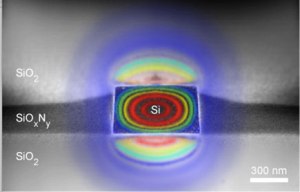Aug 3 2010
IBM researchers have developed a new silicon optical amplifier using a cost-effective silicon process. The silicon optical amplifier was fabricated by utilizing the silicon photonic waveguides that are normally employed in telecommunications optical interconnects.
 Scanning electron microscope image of silicon nanophotonic waveguide
Scanning electron microscope image of silicon nanophotonic waveguide
The optical amplifier aims the mid-infrared band utilized by industrial process monitors, medical imagers and heat sensors. The sensors utilize the mid-infrared wavelengths beginning at 2,200 nm, while the telecommunications sector utilizes the near-infrared band in wavelength of 1,500 nm. The United States military force employs mid-infrared wavelengths for sensors and for tracking environmental heat sources.
The heat sensors sense a weak heat source and change the heat source into an electrical signal and then finally amplify the signal. This technique also amplifies the conversion noise. Prior to the signal conversion process, the optical amplifier utilizes 4-way mixing to increase the optical signal.
William Green, IBM researcher, stated that the team has achieved a significant optical amplification, and despite all the chip and fiber coupling losses the all-optical amplifier has achieved a gain of 13 dB.